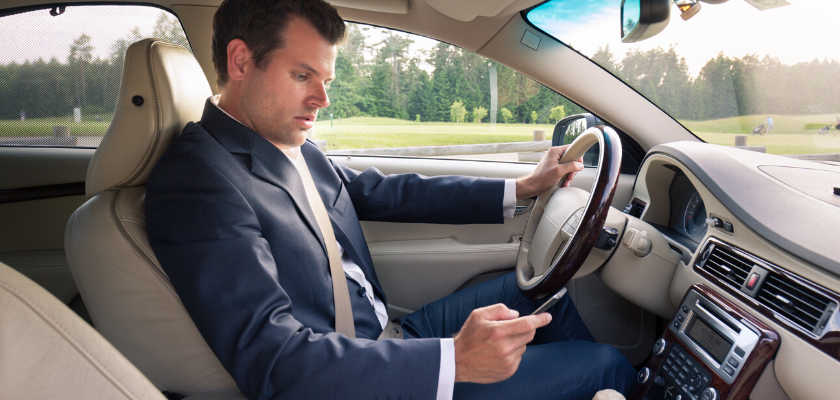How to Help Stop Texting and Driving: A Complete Guide (2024)

According to the National Safety Council, more than 700 people get injured in driving collisions caused by distractions on an average day. With the continued proliferation of personal devices, that number is on the rise.
For companies that manage fleets of commercial drivers, distracted driving represents a tremendous liability, threatening safety, and increasing insurance and claims costs.
Distractions are everywhere
Anything that takes someone’s eyes, mind, or hands away from the road is a distraction. Distractions can include things that drivers may need to do, like:
- Texting
- Adjusting heat or air conditioning
- Taking a quick sip of water
- Glancing at navigation
While it may be impossible to avoid distractions entirely, it's important to identify and prevent risky distractions that are closely associated with collisions, so you can keep your drivers safe and protect your bottom line.
Learn more about distracted driving.
Tips to help your drivers stop texting and driving
Texting while driving is one of the most dangerous and common distractions on the road, because it can involve multiple distractions occurring at one time, taking a driver's hands, eyes, and mind off the road. Texting while driving solutions should be a focus area within a larger distracted driving program that takes all types of distractions into account.
Solutions to texting and driving
Addressing distractions is a significant focus area for many fleet managers due the life-threatening risks. Thousands of preventable collisions a year are caused by texting and driving. And yet, because distraction comes in so many forms, it’s also a challenging problem to solve, requiring constant attention and multiple approaches.
Focus on building a strong safety culture within your organization, then add technology to help you identify risk in real-time, coach your fleet using clear video evidence, or track progress toward your goals.
Building a culture to address distracted driving
Building a strong safety culture is key to establishing a shared understanding of expectations, rewards, and consequences within your fleet.
Establishing a safety code of conduct
A good first step is to establish a safety code of conduct for your organization that outlines safety policies.
Here are some details your code could include:
- A safety mission statement
- Specific examples of how your organization defines distractions and risky behavior
- Policies and procedures for daily operations
- Consequences for engaging in risky driving
- Rewards available to recognize good driving behavior
- A simple incident reporting process
- Measurable safety goals
If your organization already has a code of conduct in place, it’s a good idea to review it with a fresh set of eyes. Your code of conduct could be updated as needed each year to make sure it remains relevant and effective as technology, laws, and organizational goals change from year to year.
Sharing your policies around safety, including texting and driving
Once your organization’s safety code of conduct is in place, don’t let it gather dust on a shelf. To bring policies to life, you’ll need to take every opportunity to share and discuss them with your drivers. The idea is to make this critical information second nature so that it's ingrained in the way your fleet behaves every day.
Here are a few ideas to ensure that your safety and distracted driving policies stay top of mind:
- Include safety and distracted driving on the agenda during weekly or monthly meetings
- Celebrate safety wins and opportunities as a group
- Ask for feedback, tips and tricks, and stories from the road from those driving
- Incorporate your code of conduct during new employee orientations, ongoing training programs, and annual employee reviews
- Share updates from leadership on how the team is tracking toward safety goals
- Post your code of conduct where people will see it on a regular basis
- Pick areas of focus from your code of conduct to highlight on a monthly or quarterly basis and offer focused training to refresh your drivers’ skills
Building a system of rewards and consequences
Once you have socialized and communicated your code of conduct, make the policies real by showing your drivers what’s in it for them when they drive safely and what could be at stake if they don’t. This is your organization’s opportunity to “walk the walk.” Being consistent and fair will help you gain the trust and help your fleet understand that they have direct control over their performance.
By recognizing and rewarding those who demonstrate good decision making while on the road, you will positively reinforce safe behaviors, further embedding safety in your fleet’s culture
Using technology as a solution
The right technology can help support your safety culture and distracted driving programs. The best policies and procedures can only go so far if you aren’t able to monitor driver behavior to see when rewards are due and where the opportunities for coaching exist.
That’s where a distracted driving technology platform can come to the rescue. technology can provide you with the insights you need to take consistent action to eliminate distractions behind the wheel.
Video telematics, when combined with machine vision and artificial intelligence (MV+AI) technology, goes beyond traditional telematics to reveal how your fleet performs and what’s really happening on the road at any given time.
Traditional telematics systems can provide fuel data and information about certain types of erratic driving like hard braking, swerving or collisions, relying on data from onboard systems in the vehicle, but lack the ability to detect more subtle risks until they result in a physical change to the vehicle’s speed or position.
Some video telematics providers, like Lytx, offer MV+AI-enabled dash cams. These devices capture video evidence that allows you to see the greater context and flagging moments of distraction like using cell phones or eating behind the wheel.
The systems can be your eyes and ears anywhere your fleet goes, helping you understand where coaching opportunities exist and when rewards for safe driving are due. They help you switch from reactive issue management to the ability to address risk proactively, as it occurs.
Ongoing driver coaching
For fleets that want to take their safety programs to the next level, the evidence companies gain from video telematics solutions can be leveraged to coach drivers. You can use the patterns and incidents that telematics, MV+AI, and video technology reveal as powerful coaching and training tools.
For strong results, coaching needs to be an ongoing and consistent part of your organization’s safety practice. One way to build coaching into your program is to have managers sit with drivers each month to watch flagged video clips together, talk about how and why the driver was distracted, and discuss the risk that distraction represents. Conversations should stay focused on education over punishment.
Coaching can take on a variety of different forms; from weekly or monthly scheduled meetings, to remote coaching and one-on-one meetings. Greater awareness and smart in-cab alerts can also help people self-coach. Each company can tailor the feedback process to suit its needs.
It can also be helpful to see how other companies have embedded safety coaching within their organizations. Sysco, Concho Valley Transit District, and Murphy-Hoffman Company offer excellent examples of companies that have prioritized safety coaching and seen great results from their efforts.
How Lytx helps detect and prevent distracted driving
Finding ways to detect and prevent distracted driving is something Lytx has been doing for over 20 years, longer than any other company in the industry. Lytx video telematics systems have collected 185 billion miles of driving data. This massive and unique data set is the largest of its kind in the world, providing a foundation for Lytx to develop innovative and accurate technology that improves fleet safety and performance.
Newly expanded machine vision + artificial intelligence capabilities
Lytx offers industry-leading technology to detect a wide range of risky behaviors by combining machine vision and artificial intelligence (MV+AI) with telematics sensors. Lytx presents a superior and accurate view of risk across more than 60 risky driving behaviors.
Machine vision collects images from multiple sources, such as advanced sensors on vehicles. This data is then processed and analyzed by artificial intelligence algorithms to determine trends in events or behaviors, helping fleets detect and predict risk with more accuracy than ever before.
The algorithms are constantly getting “smarter” because of our DriveCam cameras, the foundational hardware in all of our fleet management solutions. Lytx captures over 97.5 million miles of data every day. As this data accumulates, risk insights become more refined and fleets learn exactly where the biggest dangers hide on the road.
Lytx continues to expand its MV+AI capabilities to accurately detect and record instances of risky and distracted driving based on factors inside and outside of the vehicle, including:
- Texting and driving
- Cell phone use
- Not wearing a seatbelt
- Smoking
- Eating or drinking
- Rolling stops
- Following distance issues
- Lane departures
Thanks to an unparalleled database of billions of miles of driving data that undergoes professional human review to validate and categorize risk, Lytx can deliver relevant and accurate insights, filtering out false positives to keep notifications actionable and workloads manageable.
This MV+AI technology allows Lytx to identify risk both inside and outside the vehicle, helping companies detect and correct distracted driving with a high degree of accuracy for difficult to detect behaviors. In 2021, Lytx analyzed and labeled more than 133 million driving events capturing key causes of driver distraction and increased risk, including cell phone use, driver unbelted, smoking, and food/drink consumption.
For example, if a driver is using a cell phone in a way that represents distraction and risk, even if it is out of direct view of the camera, the system may recognize the behavior and still automatically capture a video recording. Management will receive a notification of the issue along with a video clip in their dashboard, providing context that can be used to proactively coach drivers to change their behavior.
Modular, customizable solutions for distracted driving and texting while driving
Lytx offers a range of solutions to address distracted driving based on your organization’s needs.
Each solution is built around our intelligent and innovative dash cams that accurately detect and record the moments that matter.
- Fleet dash cams: Our cloud-connected dash camera system, combined with the Lytx Video Platform, delivers reliable, continual video clips to a searchable online dashboard. With all of your video available to you online, you can easily find the exact clips you need within minutes* of footage being captured, providing a faster way to the truth when something goes wrong and the ability to see what really happened when you suspect distracted behaviors may be an issue within your fleet.
- Fleet tracking: Our fleet tracking system builds on the functionality of our dash cams, allowing fleet managers to use GPS to track vehicles to help meet customer demand for fast, accurate, and seamless service and ensure operational efficiency.
- Fleet safety: Our most comprehensive fleet safety management system helps you pinpoint risk and offers proven, video-based coaching options to help develop and train your fleet to avoid distractions and continuously improve their performance.
To learn more about how Lytx’s MV+AI video technology can help reduce distracted driving in your fleet, book a demo with a specialist.

